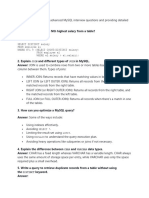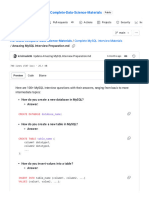0% found this document useful (0 votes)
8 views5 pagesMySQL IQAdocx
The document contains a list of MySQL interview questions and answers covering various topics such as SQL commands (DELETE, TRUNCATE, DROP), types of joins, the WHERE clause, primary and foreign keys, handling NULL values, subqueries, and performance validation techniques. It also discusses tools for connecting to MySQL databases and the integration of test automation tools like Selenium with MySQL. Additionally, it includes repeated SQL interview questions related to data retrieval and manipulation.
Uploaded by
Mythilan MythilanCopyright
© © All Rights Reserved
We take content rights seriously. If you suspect this is your content, claim it here.
Available Formats
Download as DOCX, PDF, TXT or read online on Scribd
0% found this document useful (0 votes)
8 views5 pagesMySQL IQAdocx
The document contains a list of MySQL interview questions and answers covering various topics such as SQL commands (DELETE, TRUNCATE, DROP), types of joins, the WHERE clause, primary and foreign keys, handling NULL values, subqueries, and performance validation techniques. It also discusses tools for connecting to MySQL databases and the integration of test automation tools like Selenium with MySQL. Additionally, it includes repeated SQL interview questions related to data retrieval and manipulation.
Uploaded by
Mythilan MythilanCopyright
© © All Rights Reserved
We take content rights seriously. If you suspect this is your content, claim it here.
Available Formats
Download as DOCX, PDF, TXT or read online on Scribd
/ 5























































































